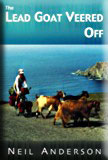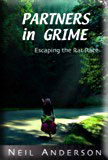|
Ring of Hook We quickly packed and fled our bug infested camping spot. I didn't think I would be able to stand having that many bugs around me all the time. The cool breeze on my skin felt wonderful, and only the persistence of phantom bites marred my exhilaration at having escaped in one piece. Sharon had to go like a bear in the woods and stopped at a small hardware store to use their facilities. She was turned away. The proprietor advised Sharon "to call" at Wellington Bridge--some twelve kilometers away. Her twisted features registered her evident pain. I suggested she make a deposit on their door step, but Sharon opted for the less radical approach and visited the nearest bush, all the while complaining "obviously that guy has never tried to cycle twelve kilometers with an urgent need to crap." At Wellington Bridge we bought groceries. I used the £5 Irish note Eileen had given me with the instructions: "Buy yourself a Guinness." I bought milk. I was still practicing for Guinness. None of the villages we passed had banks. The cashier at the Wellington Bridge store informed me, "There used to be a mobile bank that came here, but it doesn't anymore. It wasn't profitable. Most people have cars nowadays anyway, so they just drive to the city whenever they need a bank." Picnic tables outside the grocery store were strategically located in front of a semi-circular canal. In the muggy air we could watch water fowl and passing traffic as we ate our omelets. Pitting in for a leisurely lunch, we occupied the table for two hours, reading the newspaper and waving to loaded cycle-tourists, including one couple on a tandem. They cruised by in colorful groups of twos and threes. As we prepared to leave, three touring Australians (Pat and Bill ("call me Wall") Wallace and their daughter, Marcie) with bulging packs the size of hockey bags, stopped for a snack. Marcie, a dashing redhead, had connected a couple of days ago with her parents at the Dublin airport. Pat and Wall were on a four-month trip and had already burned up three months. "We spent most of our time in Greece and a bit in Turkey," Wall said. "We were going to do some eastern bloc countries and France too, but visas were too much trouble so we flew from Athens to London instead." I had already noticed Ireland produced batches of redheads in all shapes and sizes. Pat and Wall's daughter, with her red hair and fair complexion, looked like any other local. "Ireland is the first place I've felt like I fit in," Marcie confessed. No one looked twice at her here. Ignoring our lack of Irish money Sharon and I took route R733, to the turnoff for Tintern Abbey. Three Gypsy caravans, in sad shape, nestled in the trees along the abbey road. An assortment of children's toys laid scattered about and the requisite line of drying laundry flapped in the breeze. Eleanor, a volunteer at the information hut, wore a dark green skirt and a light green blouse. Green was a perfectly acceptable, even common, clothing colour in Ireland. (It was no myth; the Irish liked green. Almost everything was green in Ireland, not only the countryside, but also the reflectors on road warning signs, telephone booths, post office boxes, post office trucks, various town buildings, signs in towns for businesses and, the ubiquitous three-leaf clover.) Eleanor implanted us with her considerable historical knowledge of the abbey and shared a summary of the area. Cistercian monks once inhabited the abbey. The Normans invaded in 1170 ad and greatly influenced this area. Eleanor talked about the eons gone by as if they were yesterday. I noticed people in the old countries looked at years differently than we did in North America. Two hundred years ago, to send troops to the coast for a presumed invasion, the islanders built route R733. Eleanor still referred to it as "the new line." I asked Eleanor where the nearest bank was. She squawked, "The bank is quite a ride from here. But if you'se go into any pub and yell out, 'Does anyone here want to change a few Irish pounds?' someone probably will." Eleanor told us she had borne seven kids over a twenty-two year period. They now ranged in age from thirty down to eight. Eleanor was a true optimist--she expressed it was wonderful being a parent. And, unlike parents who baby-sat grandchildren, Eleanor sent her youngest to her oldest for them to baby-sit! Sharon and I wandered the abbey grounds. There were thick woods surrounding the area. An algae clogged stream burbled behind the abbey. Sharon looked over the bridge and saw a large black rat lapping up greenish water. A classic scene -- exactly what I think of when I tour old abbeys. On our way out we stopped to say thanks to our friendly host. Eleanor squinted in the sunlight, "I was jus' t'inkin.' 'Ave you'se an English tenner?" "I think so," I affirmed, digging into my pocket. With a perplexed look, Sharon wondered what on earth I was talking about. Tenor? What does he mean he thinks so? Neil can barely hum a few bars; let alone consider himself a tenor. It wasn't until I dug out a £10 English note that the light bulb went on in Sharon's head. Eleanor kindly gave me an Irish £5 note and 5 heavy £1 Bank of Ireland coins in return. I didn't even have to pay commission. We followed the Ring of Hook to Europe's oldest lighthouse at Hook Head. On the windswept tip unofficial signs warned of sinkholes. An ominous once-orange life preserver clung to a post with a length of coiled pale yellow rope, fibers unraveling its length like split-ends. On the rocky point, Hook Head lighthouse stood like a tired one-eyed sentry. A light had been continuously maintained on that site for over 1500 years. The roads became extremely choppy and malformed. One time I stopped, and clouds appeared to be converging to a vanishing point in fast forward before my eyes. It felt like my optic nerves were jiggling, attached to the ends of coiled springs. At a dead-end gravel road into the sea, eating Irish stew, Sharon and I watched the sun set. From my rocky perch I spied Slade castle off to one side, Hook lighthouse off to the other, and the ruin of a hoary fort farther along the coast. We set up camp amid buzzing Irish flies are smiling. We were behind a hedgerow as a wind shelter on the edge of a farmer's cut grass field. We had a full view of the shore line as we were only metres away from the embankment. |
|
|


